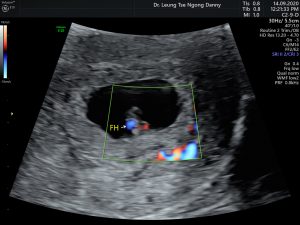1.The condition of ‘pregnancy of unknown location’
- Sometimes in the presence of a positive pregnancy test, the pregnancy cannot be located within or outside the uterus by ultrasound at a maturity when it should be seen. This is called ‘pregnancy of unknown location (PUL)’;
2. What can be the underlying causes for PUL?
There are 3 main causes:
- Wrong maturity (called ‘Date problem’)
There is a mistake in the calculation of the maturity. It is most commonly due to late ovulation, resulting in delayed fertilization. Hence, the pregnancy at 5 weeks after the last menstrual period does not equate 3 weeks but only 1-2 weeks after conception. At such an early state of pregnancy, the gestational sac cannot be seen yet.
- Early pregnancy failure
- Ectopic pregnancy
In case the pregnancy is located in the fallopian tube or the ovary, the gestational sac will not be seen inside the uterine cavity. At an early gestation, a small tubal or ovarian pregnancy cannot be easily picked up on ultrasound.
3. Steps in finding the underlying diagnosis
- Detailed information on the menstrual history especially the cycle length
- Date of first pregnancy test
- History of bleeding or passage of tissue mass
- Results of the previous ultrasound scan, if any
- Serial serum human chorionic gonadotrophin (HCG) levels
4. Serum HCG
- A hormone produced by the live placental cells and is found in the mother’s blood;
- If HCG >2000 IU/L, intrauterine gestational sac should be seen on ultrasound. Failure of detection of intrauterine sac points to a high suspicion of ectopic pregnancy;
- For normal intrauterine pregnancy, the rise of HCG should be > 66% in 48 hours. In case of failed pregnancy, the HCG levels will fall substantially. For ectopic pregnancy, it is hard to tell as the HCG levels may rise or fall or even be static. In most of the cases, the rise or fall will be ~20-30% only.
5. Follow-up
Follow-up is essential until the underlying diagnosis is identified and properly managed.


